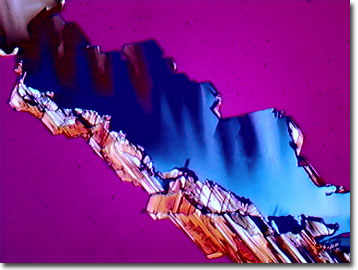Polarized Light Digital Image Gallery
Norepinephrine
As a neurotransmitter in the catecholamine family, norepinephrine mediates chemical communications in the autonomic nervous system's sympathetic network. Norepinephrine is released at the synapses (in a manner similar to other neurotransmitters), transmitting neural signals from a nerve to other cells in the body.

View a second image of norepinephrine.
Almost structurally identical to epinephrine, both organic compounds increase heart rate and blood pressure and decrease digestion in the gastrointestinal tract during the fight or flight mode of the sympathetic nervous system. Norepinephrine also triggers increases in the conversion of glycogen to glucose in the liver (glycogenolysis), assists in the conversion of fats to fatty acids in the adipose tissue (lipolysis), and is responsible for relaxation of the bronchial smooth muscles, opening the air passages to the lungs. Known also as noradrenaline, norepinephrine is produced in small amounts as a hormone by the adrenal medulla. Synthesized in the laboratory as a bitartrate formulation, norepinephrine is prescribed for blood pressure control, spinal anesthesia, and as an adjunct for treating cardiac arrest.
To biochemists, norepinephrine is also known as leva-arterenol, and it differs from epinephrine by the absence of a methyl group on the nitrogen atom. With 15 carbons, 11 hydrogens, and 5 oxygens, noradrenaline is biosynthesized from amino acids, including phenylalanine and tyrosine, and is facilitated by vitamins B-6 and C. Hallucinogens such as the Amanita muscaria mushroom increase dopamine concentrations while decreasing norepinephrine, creating an imbalance in the neurotransmitters. Tricyclic antidepressants block the uptake of norepinephrine and serotonin, resulting in increased availability in the autonomic nervous system. The euphoria felt during cocaine ingestion derives from its powers to activate norepinephrine while inhibiting serotonin, resulting in the brain "racing" until it exhausts the norepinephrine supply.
Contributing Authors
Omar Alvarado, Thomas J. Fellers and Michael W. Davidson - National High Magnetic Field Laboratory, 1800 East Paul Dirac Dr., The Florida State University, Tallahassee, Florida, 32310.
BACK TO THE POLARIZED LIGHT IMAGE GALLERY
BACK TO THE DIGITAL IMAGE GALLERIES
Questions or comments? Send us an email.
© 1995-2025 by Michael W. Davidson and The Florida State University. All Rights Reserved. No images, graphics, software, scripts, or applets may be reproduced or used in any manner without permission from the copyright holders. Use of this website means you agree to all of the Legal Terms and Conditions set forth by the owners.
This website is maintained by our
Graphics & Web Programming Team
in collaboration with Optical Microscopy at the
National High Magnetic Field Laboratory.
Last Modification Friday, Nov 13, 2015 at 01:19 PM
Access Count Since September 17, 2002: 16206
Visit the website of our partner in introductory microscopy education:
|
|
